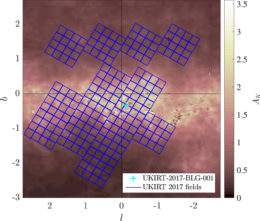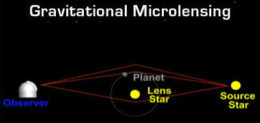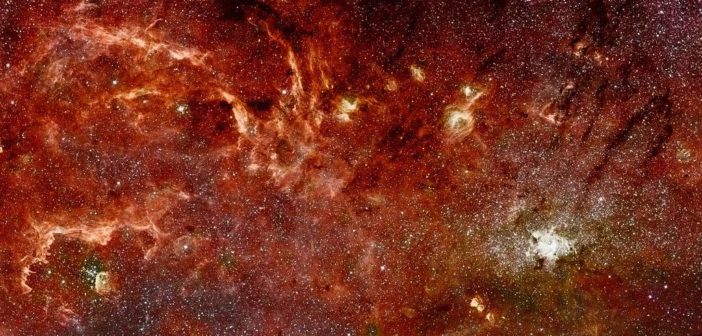Finding planets in the crowded galactic center is a difficult task, but infrared microlensing surveys give us a fighting chance! Preliminary results from such a study have already revealed a new exoplanet lurking in the dust of the galactic bulge.
Detection Biases

UKIRT-2017 microlensing survey fields (blue), plotted over a map showing the galactic-plane dust extinction. The location of the newly discovered giant planet is marked with blue crosshairs. [Shvartzvald et al. 2018]
For this reason, microlensing surveys for exoplanets have something new to add to the field.
Search for a Lens
In gravitational microlensing, we observe a background star as it is briefly magnified by a passing foreground star acting as a lens. If that foreground star hosts a planet, we observe a characteristic shape in the observed brightening of the background star, and the properties of that shape can reveal information about the foreground planet.

A diagram of how planets are detected via gravitational microlensing. The detectable planet is in orbit around the foreground lens star. [NASA]
In a new study led by a Yossi Shvartzvald, a NASA postdoctoral fellow at the Jet Propulsion Laboratory (JPL), a team of scientists now presents preliminary results from a near-infrared microlensing survey conducted with the United Kingdom Infrared Telescope (UKIRT) in Hawaii. Though the full study has not yet been published, the team reports on their first outcome: the detection of a giant planet in the galactic bulge.
Giant Planet Found

The light curve of UKIRT-2017-BLG-001. The inset shows a close-up of the anomaly in the curve, produced by the presence of the planet. [Shvartzvald et al. 2018]
The star–planet pair is roughly 20,500 light-years from us, which likely places it in the galactic bulge. Intriguingly, evidence suggests that the source star — the star that the foreground star–planet lensed — lies in the far galactic disk. If this is true, this would be the first source star of a microlensing event to be identified as belonging to the far disk.
Looking Ahead
What’s next for microlensing exoplanet studies? The goal of the UKIRT near-infrared microlensing survey isn’t just to discover planets — it’s to characterize the exoplanet occurrence rates in different parts of the galaxy to inform future surveys.
In particular, the UKIRT survey explored potential fields for the upcoming Wide Field Infrared Survey Telescope (WFIRST) mission, slated to launch in the mid-2020s. This powerful space telescope stands to vastly expand the reach of infrared microlensing detection, broadly surveying our galaxy for planets hiding in the dust.
Citation
Y. Shvartzvald et al 2018 ApJL 857 L8. doi:10.3847/2041-8213/aab71b


